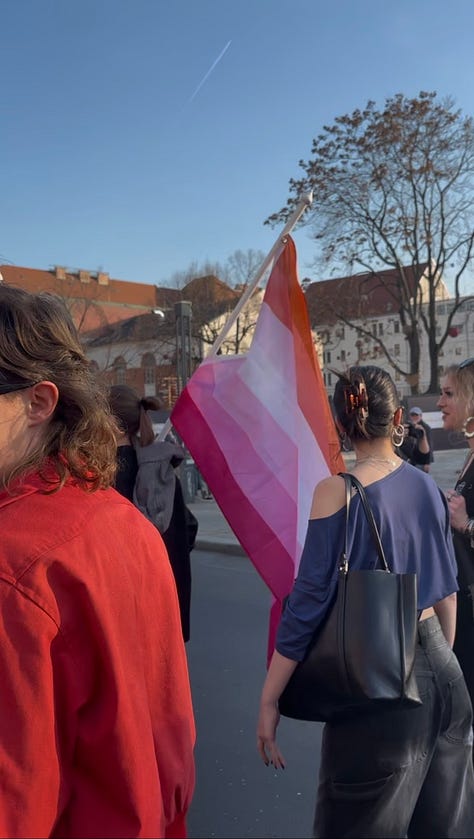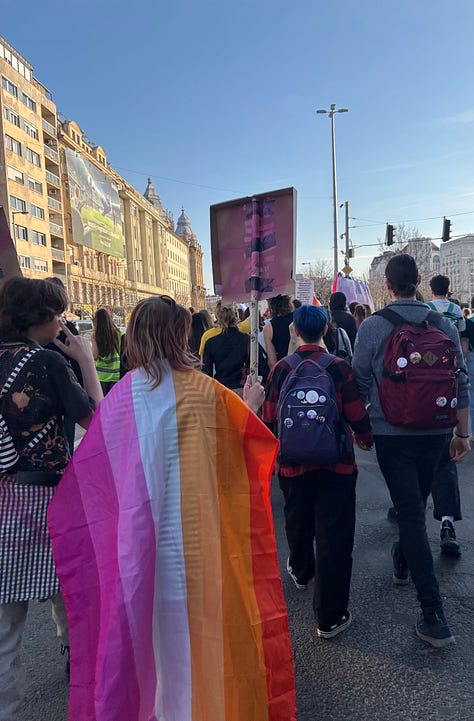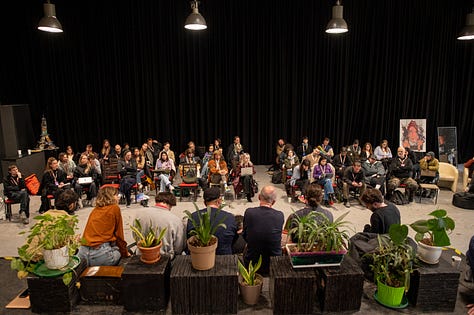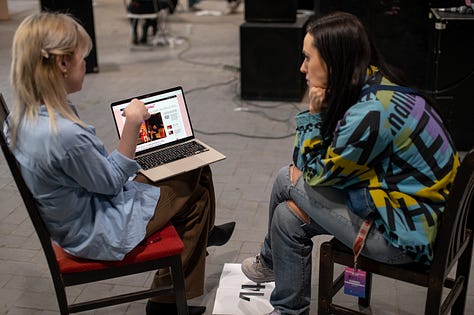Pretty Lies: How Conservative Rhetoric Dresses Up Control
Tradwives, Clean Girls, and the War on Pride
Hi Lazies,
In a world increasingly shaped by conservative rhetoric these days, the fight for freedom, equality, and self-expression often feels like a battle against well-coordinated, deeply entrenched narratives. From bans on Pride parades to the resurgence of nostalgic, gendered ideals like the ‘tradwife’ or the ‘clean girl,’ conservative movements are increasingly influencing cultural, political, and social spheres. Yet, as we’ve seen time and time again, rhetoric is never just words — it’s power in action.
This issue digs deep into these dynamics, unmasking the tools of control that work to suppress identity, silence dissent, and reframe resistance. Through protests, aesthetics, and cultural backlashes, we explore how the conservative narrative has evolved — and how we, as feminists and global citizens, are fighting back.
This issue features illustrations from Dinara Satbayeva and Paulina Odeth
Your Lazies
In April, we asked our members to reflect on the conservative rhetoric and share their thoughts on that.
Lazy Maria — on Pride being banned in Hungary:
I’m journaling, and there are bombs in my mind. The world is on fire, I know. Here we are in front of the Cathedral. Someone has thrown a piece of fruit from a window — on purpose, I think. Flags, pastel and vibrant colours are the weapons that represent a threat to many. Looking around is like remembering the parades from the past, but it’s not quite the same. It’s lugubrious. In the 90’s, someone dared to identify publicly as both queer and Hungarian on the first pride parade, and take as theirs the identity of this country: “Édes hazám, fogadj szivedbe, hadd legyek …!” (My sweet homeland, take me to your heart—let me be/exist!)1. If we think about reclaiming rights back, as every citizen should supposedly have the same freedoms in a democratic country, who would be to blame for seeking a home in words from József Attila or in the figure of Károly Mária Kertbeny, both prominent exposers of Hungarian culture in its prime? It can be seen, rightfully, as a reconfiguration of cultural and political legitimacy2, but in the universal search for identity and belonging, how can one feel safe without community? A shelter where to grow, express freely and simply exist without being filtered by repressive narratives.
Trying to find a way in the midst of the increasing conservative rhetorics in the world, but especially now in Hungary, is a challenge. Since March, the threat to the LGBTQ+ movement has escalated by the passing of a new legislation that bans Pride and events related to it. This law was pushed through the legal channels and signed in less than 24 hours (talk about efficiency), and it essentially violates the right of freedom of assembly and speech while encouraging discrimination.
In the past weeks, there has been an organised protesting schedule on Tuesdays in order to set a stand against this autocratic decision. The result has been protesters taken to police stations and others fined an amount of 200.000 HUF (almost 500 euros) on the spot.



The criminalisation of dissidents is real. Are you pro-interest of your nation or are you a threat to it? There’s no in-between from the official standpoint. Some people are scared, some others feel defiant. Facial recognition tools and surveillance on the spot will be used in any gathering of this nature, even by just expressing discontent. It sounds dystopian, but to be fair, everything in the world does now.
Lazy Harshita — on tradwives:
Because Apparently the 1950s Needed a Reboot.
You’ve probably heard someone on TikTok, Instagram, or that one suspiciously put-together mom in your apartment building mention having a "tradwife moment." And you're like — what in the 1950s is going on?
What Even Is a Tradwife Moment?
Picture this: you’re wearing a cute apron (probably floral), there’s bread rising on the counter, soup simmering on the stove, and you’re smiling sweetly at a husband who definitely cannot find the TV remote without your assistance.
That, my friends, is a tradwife moment.
It's when someone leans hard into the "storybook wife" vibe — baking, homemaking, being the CEO of Domestic Affairs — and either does it for real... or as a hilarious, slightly ironic joke. Example: burning toast but proudly calling it a "tradwife moment" because you tried.
Why Is It Called a Movement and Not Just "Tuesday"?
Because it’s not just one person playing house. It's millions of women saying: "You know what? Maybe vacuuming with pearl earrings on is the move." And when a bunch of people start doing something together on purpose, it becomes a movement.
When Did This Madness Start Again?
The OG tradwife vibes? Super old. Like, your grandma’s grandma old. But the modern, Instagram-filtered version? It started popping off around 2018–2019. Somebody posted a video baking sourdough while smiling like a Disney princess, and next thing you know — boom — thousands of women said, "Sign me up, I want that wholesome life too."
Why Did It Start Again? (And Was Mercury Retrograde Involved?)
Honestly, kind of. Here’s the thing no one says out loud: When women entered the workforce (yay feminism!), they didn’t just get 9–5 jobs. They also still had to come home...and cook dinner, do laundry, clean up, soothe crying kids, make the science project volcano, answer the PTA emails, and basically run an unpaid second shift called "home management." It. Was. Exhausting.
Somewhere between "leaning in" and "burning out," a bunch of women looked around and said: "Wait a second, this isn’t the freedom we were promised." So part of the tradwife movement was women saying:
"Hey, what if choosing traditional roles is empowerment too?"
"What if I don’t have to do everything to be valuable?"
"Also, homemade jam slaps."
Add in a dash of Instagram nostalgia, a sprinkle of sourdough starter, and a big pinch of modern burnout — and voilà! Tradwife trend, served hot.
Is This Still a Thing in 2025, or Did It Crumble Like a Bad Pie Crust?
Still a thing. Very much still kneading dough and kneading validation. In 2025, the tradwife energy is alive and well-fed — but it’s shapeshifted. You’ve got influencers like Hannah Neeleman (aka Ballerina Farm) and Nara Smith showing the wholesome side: making butter from scratch while simultaneously building empires.
Meanwhile, some women who were deep in tradwife land have posted honest stories like: "Yeah, so, turns out I kinda miss having my own money and not folding 47 pairs of toddler socks every day." So now, the tradwife movement is less "one-size-fits-all" and more "choose your own bread-scented adventure."
A tradwife moment is when you dramatically (or genuinely) embrace a life of love, loaves, and laundry. It became a movement because a lot of women realised that maybe slow, cozy living isn’t lame — it’s actually rebellion against the noisy mess called modern life. And yes, it’s still here in 2025, wearing a linen dress and baking banana bread, but also occasionally side-eyeing capitalism and ordering Uber Eats because, hey, balance.
Life’s short. Whether you’re slaying corporate dragons or making pie crusts from scratch, make sure you’re doing it because you want to — not because Chad on Twitter thinks you should.
Aprons on, feminism intact. Let’s ride.
Lazy Julie — on fresh face of old politics:
Her skin is smooth, her hair is oiled and pulled into a slick bun. Her makeup is strictly ‘no-makeup’ one; her nails are done, but not ‘too much’. Her whole existence is ‘not too much’. Her clothes are neutral-colored, she eats clean... In fact, she is the ‘clean girl’ herself. I hate her with my whole heart — but thousands of women online want to be her.
Now, where do we go from here?



The "clean girl aesthetic" is a beauty trend — minimal makeup, slicked-back hair, neutral-toned outfits, small gold hoops, natural brows, dewy skin. Think "effortless" perfection or — Hailey Bieber, the one who popularised and successfully commercialised the trend with her skincare brand Rhode. The aesthetic exploded through TikTok, Instagram, and Pinterest in 2022–2024, along with many other manifactured trends.
What Do The Critics Say?
Sophie Lewis ("Abolish the Family") would argue it's about re-domesticating women through beauty labour.
Angela McRobbie (feminist media scholar) might call it "post-feminist masquerade" — pretending freedom while reasserting old roles.
This aesthetic isn't just about skincare routines — it subtly reinforces very old ideas of acceptable femininity:
Policed presentation: "Beauty" becomes a duty tied to purity, effortlessness, and discipline.
Class coding: It suggests you can be "clean" if you can afford minimalist luxury — the right serums, the right yoga classes, the right $50 claw clip.
Cultural erasure: It repackages long-standing beauty practices from Black, Latina, and Indigenous communities (slick baby hairs, glossy skin) while often crediting them to white or white-passing influencers.
Conservative nostalgia: It romanticises a return to "natural," "proper," "feminine" womanhood — but only if it's neat, slim (!), wealthy, and silent.
Besides that, you can only rock this aesthetic if you’re already biologically suitable for that — naturally white teeth, thick hair, skinny body. It’s very easy to say ‘oh, just don’t wear any makeup’, if your skin is already naturally perfect. Praise of biological advantage, yet again.
The clean girl is the acceptable woman: quiet, self-contained, beautiful but not loud about it, successful but non-threatening.
This mirrors broader political messaging about the "ideal citizen" — respectable, loyal, and polished, following all the orders — not "messy," woke, or activist. Go organise your little Pinterest boards and make a smoothie to match your Pilates outfit, that should keep you occupied for the rest of the day.
Lazy Chats podcast update!
In the new episode, Lazy Aleli chats with Abigail Taugwalder, founder of Garden of Abi, a space dedicated to conscious living, breathwork, and personal rituals. As a coach, breathwork specialist, and mother of two based in Paris, Abigail shares her approach to using rituals as grounding and self-care tools. Together, they explore what it means to live consciously and reflect on the challenges within today’s 'wellness' industry.
Our curated selection of articles for this month's topic:
France’s Far-Right Risk: A Wake-Up Call for Eastern Europe by Lazy Frosso
What’s a good migrant now? What the Labour win means for immigration by Lazy Selin
The German law forced me to think about it. I did it anyway by Lazy Johanna
When Your Body is the Property of a Whole Country: Testimony of a Turkish Woman by Ayse Göc
The End of Traditional Platforms: How Can Independent Media Reach Rural Women? by Lazy Dorina
Key Conservative Rhetoric Tactics (And How to Spot Them) (by Julie)
A quick disclaimer: I’m not a political scientist, nor do I claim to be an expert in it, but I do come from a country with an authoritarian regime close to the dictatorship — Russia. I believe, I’ve got a lot to say on the topic.
Here’s a little list for beginners on the conservative rhetoric — as a linguist, I find it curious to spot. When I was done with the list, I mentally checked all the points from my experience — growing up, I’ve heard ALL the points before already, constantly.
1. Moral Panic Creation
Inventing or exaggerating a social threat ("the children are at risk!", “they’re eating the dogs”, "traditional values are being destroyed!", that kind of stuff) to justify extreme measures. This one is often used during LGBTQ+ legislation drives.
Look for: emotionally charged language, urgency without clear evidence.
2. "Us vs. Them" Narratives
Basically, living under invisible threat all the time. In my childhood, it was ‘the vicious West’ narrative, constantly lurking for ways to destroy our precious country. The classic examples: the fascism or the Cold War, of course.
Look for: constant references to enemies, conspiracies, scapegoats.
3. "Restoring Greatness" Slogans
Promising a return to an idealised, often imaginary past (“Make America Great Again”). These slogans emphasise the times when "things were better" — but whose past is being remembered?
Look for: nostalgia-driven language that glosses over historical injustices.
4. Victimisation of the Majority
Claiming that the dominant group (often straight, white, Christian citizens or the dominant ethnicity) is now the “real oppressed” group.
Look for: phrases like "reverse discrimination," "they're erasing us," or "we can't say anything anymore."
5. Appeal to Tradition
Arguing that something is right or better simply because "it's always been that way.". (And anything new should be treated with suspicion)
Look for: phrases like "family values," "natural order," "traditional marriage."
6. Demonising Dissent
Labelling protest, critique, or activism as treasonous, dangerous, or "unpatriotic."
Look for: statements that equate disagreement with hatred of the nation.
7. Pseudo-Science or Misuse of Academia
Citing fringe studies, outdated theories, or bad-faith interpretations of data to justify social hierarchies. For example, conversion therapy claims that homosexuality can be "cured" — it’s been since long debunked, yet still pushed by some conservative groups.
Look for: cherry-picked statistics, "scientific" language without consensus.
8. Faux Populism
Pretending to speak for "ordinary people" while enacting policies that benefit elites. Benjamin Moffitt’s research on populism shows how elites often mask themselves as “outsiders.”
Look for: highly emotional speeches paired with corporate-friendly or anti-worker policies.
9. Identity Politics for the Majority
Claiming that focusing on marginalised groups is “divisive” — while reinforcing a dominant identity as neutral, natural, or superior. "All Lives Matter" as a response to "Black Lives Matter", attempts to reframe racial justice advocacy as "divisive" and unnecessary.
Look for: statements like "we don't see color" or "everyone's equal, so stop complaining."
10. Crisis Manufacturing
Inventing ongoing states of emergency that demand “temporary” but extreme powers (that often stick around). An example to this would be "migrant caravan invasion" narrative (US, 2018 midterms), when conservative media framed a group of asylum seekers as a national security threat.
Look for: endless talk of invasion, chaos, imminent collapse, needing strongmen.
Now you know more! Recognising these rhetorical tactics isn’t just an intellectual exercise to look cool — it’s a survival skill. When conservative narratives use fear, tradition, or identity politics to consolidate power, they aren't simply shaping opinions; they are shaping the very boundaries of who gets to belong, speak, and exist freely.
By naming these strategies, we strip them of some of their power. We see the familiar patterns behind the polished speeches and viral slogans. And once we see them, we can begin to imagine — and demand — a different future: one built not on exclusion and control, but (hopefully) on solidarity, liberation, and truth.
On April 8-9, our fellow Lazy Julie had an opportunity to represent Lazy Women at the annual Reset! network General Assembly in Skopje, North Macedonia! 🇲🇰💫
It was a 2-day event full of new connections, inspiring activities & workshops, all while learning about the independent arts, culture and media scene across the EU.
We were glad to meet like-minded people driven by common passions, share our experience of advocating for Eastern European voices in the Western feminism discourse, explore Skopje and what it had to offer, and join the Reset! workgroup on Digital Ethics!
We thank Reset! — see you next year!


📸 Marko Marjanovic Our annual memberships are still open — memberships allow us to organise meetups, an annual retreat for members only, and to fairly pay our contributors. If you want to support our work and get access to exclusive upcoming workshops next month — check out all our options here!
P.S. Our newsletter team is fully volunteer-based. We work on every issue throughout the whole month — picking a topic, collecting submissions and illustrations, writing, and editing.
If you like what we do, you can support our work via a paid subscription option on Substack. This subscription also gives you access to our Dear Lazies column, where Zsofi, our editor-in-chief, answers the questions that bother you and provides advice, thoughts, and recommendations!
Hazám (1937), Jószef Attila
Eglitis, Daina Stukuls. 2002. Imagining the nation: History, modernity, and revolution in Latvia / Burawoy, Michael, and Katherine Verdery, eds. 1999. Uncertain transition: Ethnographies of change in the postsocialist world (Eglitis 2002; Rév 1995; Verdery 1996, 1999)








Thank you Lazies for the witty and nuanced takes here!
Especially loved Harshita's take on tradwives & feminism, and Julie's list of conservatic rhetoric features! 👌